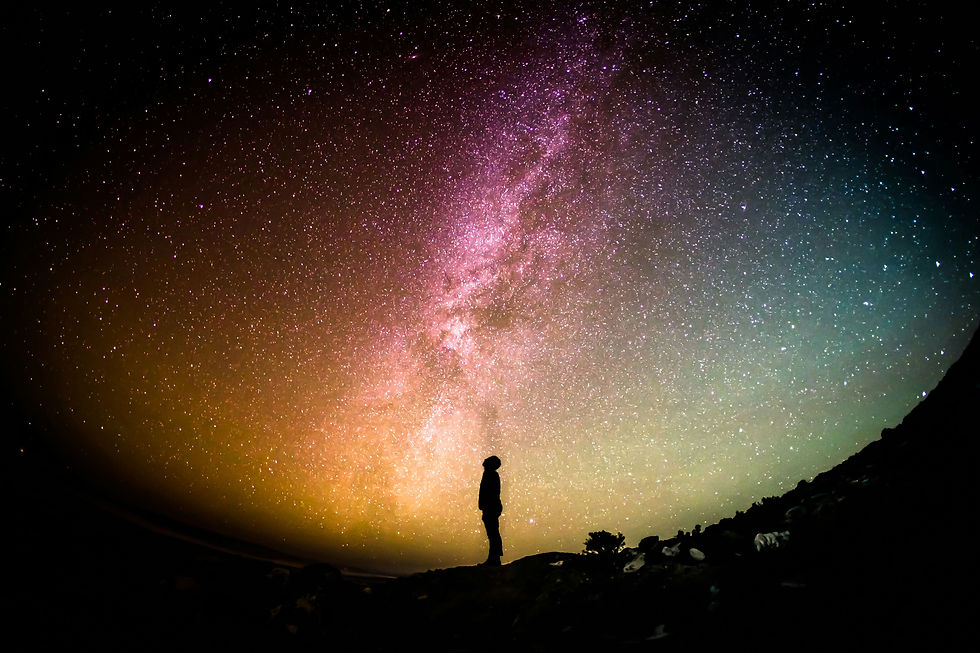Things Large
- marierhamilton3
- Jul 19
- 5 min read

You know how football teams get introduced onto the field before a game begins by running through a huge paper cheer sign, leaving it in tatters? That’s what science has done to a literal interpretation of core Christian beliefs. But in this case, there’s not much cheering from the pews.
A colleague once told me that she never understood my interest in cosmetology. I told her that in reality I have very little interest in eye shadow or tinted moisturizer. She looked at me funny.
But I do have a great interest in cosmology, the branch of physics that studies the origin and nature of the universe. I think the only way to get at the “something more," what we call God or the divine or ultimate reality, is to take a close look at the “something.” Smart people call this “natural theology.” It stands in contrast with “revealed theology,” which considers Scripture and other religious texts to be sources of religious knowledge.
For now, let’s focus on the original primary source for, well, everything: the universe itself. “Big History” is the science-based study of what happened from the first milliseconds of the universe until the present and its significance. When we talk about “history,” we usually mean “recorded history”—what we know about humans over time since we were first able to carve symbols onto stone. But that covers only about 250,000 years since humans inhabited the planet. That’s a mere .01% of the history of life on Earth. And that’s only a tiny sliver of a fraction of the history of everything that’s happened from the first seconds of the universe.[1]
Scientists divide Big History into eight segments that they call “thresholds.” Each is a time that the universe “leveled up,” so to speak. Gamers earn more and more points on one level until they reach some target, which allows them to “level up” to a new, richer, more complex experience of the game. The universe seems to do the same thing. Over unimaginably long periods of time, it scores more and more “points,” in a manner of speaking, until it reaches a new stage of greater complexity, resulting in a leap forward in its manner of being. The thresholds of Big History are the ultimate “game changers.” Each threshold’s leap forward is the result of certain specific ingredients within a perfect environment, which big historians call “Goldilocks conditions.”
The first threshold is the “Big Bang,” which is when the universe exploded into being 13.8 billion years ago. It’s mind-blowing to try to think of a “time” before the Big Bang, since time and space didn’t exist until the universe came to be. Scientists don’t yet know what caused the Big Bang, but I think one day they will. In any case, an infinitesimally small point containing some sort of particles and energy exploded forth in unimaginable heat. It immediately expanded and cooled as it did so.
The second threshold involved the creation of stars. Once the universe cooled to the point that particles could join, the simplest atoms, hydrogen and helium, formed. For millions of years, that’s all that existed. But eventually, clouds of these atoms collapsed with such heat and pressure that iron was created. The heaviness of this element led to a supernova, the explosive collapse of the star. In its fiery death, gas and dust were spread throughout space. And some of that gas and dust starts spinning together and getting hotter until… a new star is born. Then, over a period of about a billion years, the force of gravity grouped stars into galaxies.
Once the initial stars completed their very long lifespans, they died. The heat and pressure from these “supernovas” created more complex atoms, like oxygen and carbon. Their creation marks the third threshold in Big History.
The fourth involves Earth and our solar system. Our sun was (still is) a star around which bits of matter orbited. Over time, the force of gravity created collisions among this circling matter, which eventually created the planets. Scientists believe our Earth came to be about 4.5 billion years ago.
We get to the fifth threshold another billion years after that. On the ocean floors of Earth, the heat from volcanic explosions caused chemical reactions which led to the first single-celled organism. It took another billion years for multi-celled organisms to come about. These initial water-bound instances of life evolved over incredibly long periods of time, resulting in changes to existing species and the creation of new ones. And some of those changes led to species able to live on land, not just in the water. The dinosaurs flourished until about 65 million years ago, when they died out. The most accepted scientific theory for their disappearance is the impact of huge asteroid. Regardless, once they were no more, other large animals could thrive, the most successful of which is mammals. Further evolution led to primates.
The sixth threshold marks an incredible step forward: collective learning. One type of primate, called hominids, came on the scene in Africa between 5-7 million years ago. Over millions of years, this species continued to evolve achieving greater complexity, which brought about both physical and social advancements. Homo sapiens arrived on the scene only about 200,000 years ago. By creating language, we developed a way to retain knowledge for later generations, which allowed our species to leverage what came before us in moving forward.
The seventh threshold saw another giant leap forward through agriculture. Hominid species hunted and foraged for millions of years until about 12,000 years ago, when Homo sapiens began to domesticate animals and plants through farming. Since foraging was no longer necessary, humans were able to make major lifestyle changes related to the development of urban centers, various trades, and social structures.
The current threshold is known as the “Modern Revolution,” where human innovation accelerated at lightning speed due to the industrialization, the discovery of fossil fuels, digital technology, and the development of an interconnected global society. During this time, humans became the dominant global species. And what we have learned about the universe during this time is staggering.
Darwin’s work with fossil records and genetic evidence proved that all life evolves through small adaptations over long periods of time. Einstein proved that space and time aren’t two discrete things but one single “spacetime.” Massive objects like planets and stars bend spacetime around them; this curvature is what we know of as gravity. He also discovered that no matter how fast something is moving, light always travels at the same speed, which results in some wacky stuff. For instance, time actually slows down for objects moving at high speeds.
And if that’s not enough, he proved that energy and mass are pretty much the same thing. Hubble jumped on the bandwagon, and his super-cool telescope proved that our universe is expanding in all directions at a mind-blowing, Flo Jo kind of rate. And that’s just a few of the heavy hitters. All this and so much more make it clear that the universe was not created by a supernatural being with seven days to kill or a garden to populate.
But something cool is going on. Teilhard said that "things real" destroy artifice, leaving what we took a truth in tatters, like the torn through paper that announced the football team onto the field. Things large point us to the "something more."
[1] I’m not a scientist, so it’s likely I will have errors in my rudimentary explanation of big history. The OER Big History Project is an excellent, free course created by people who know what they’re talking about.



Comments